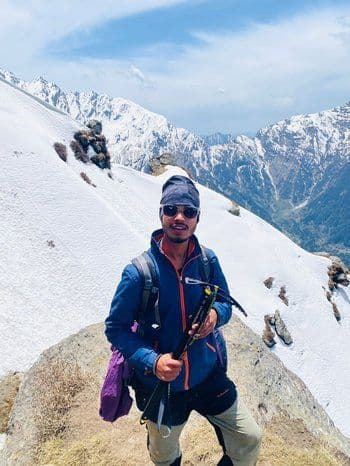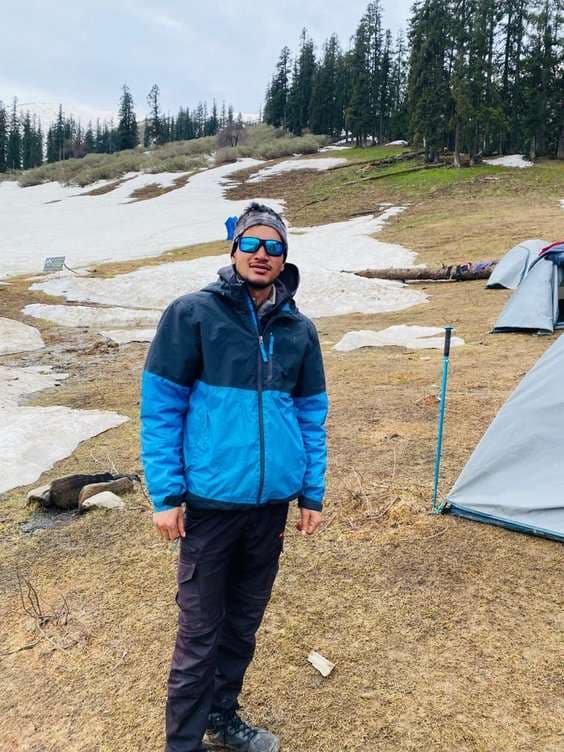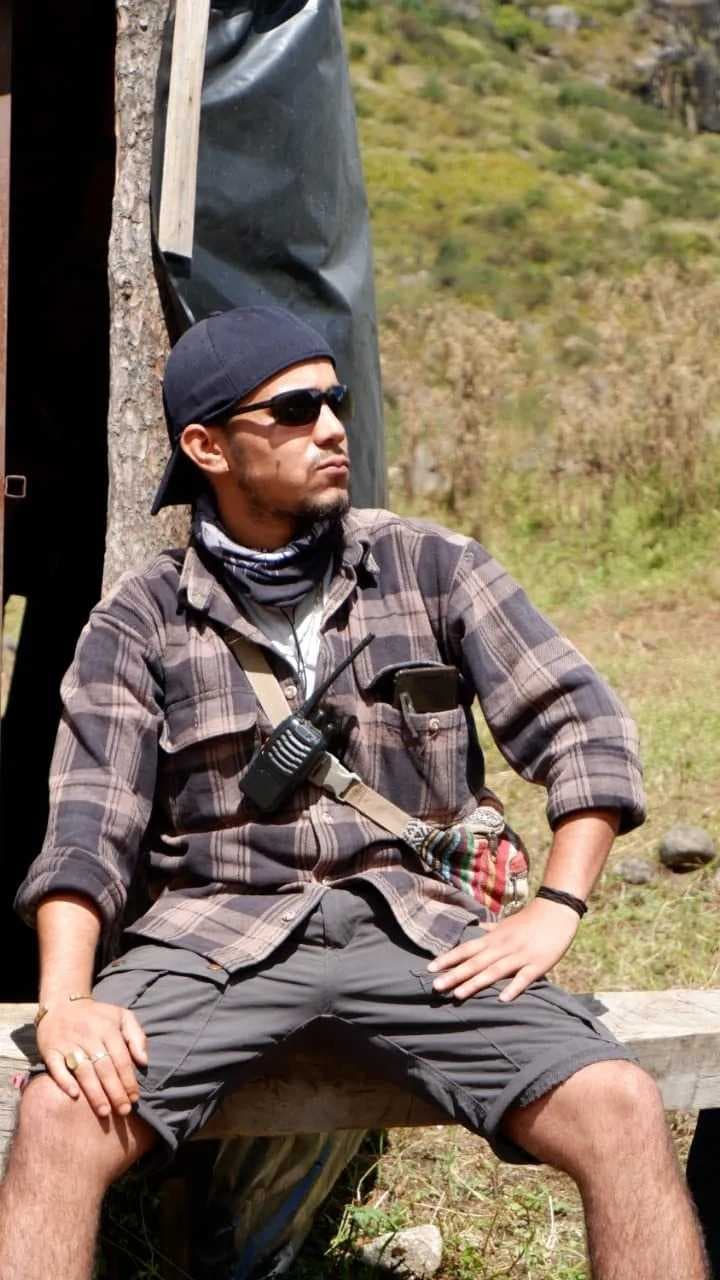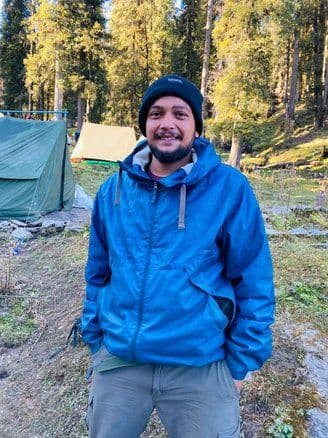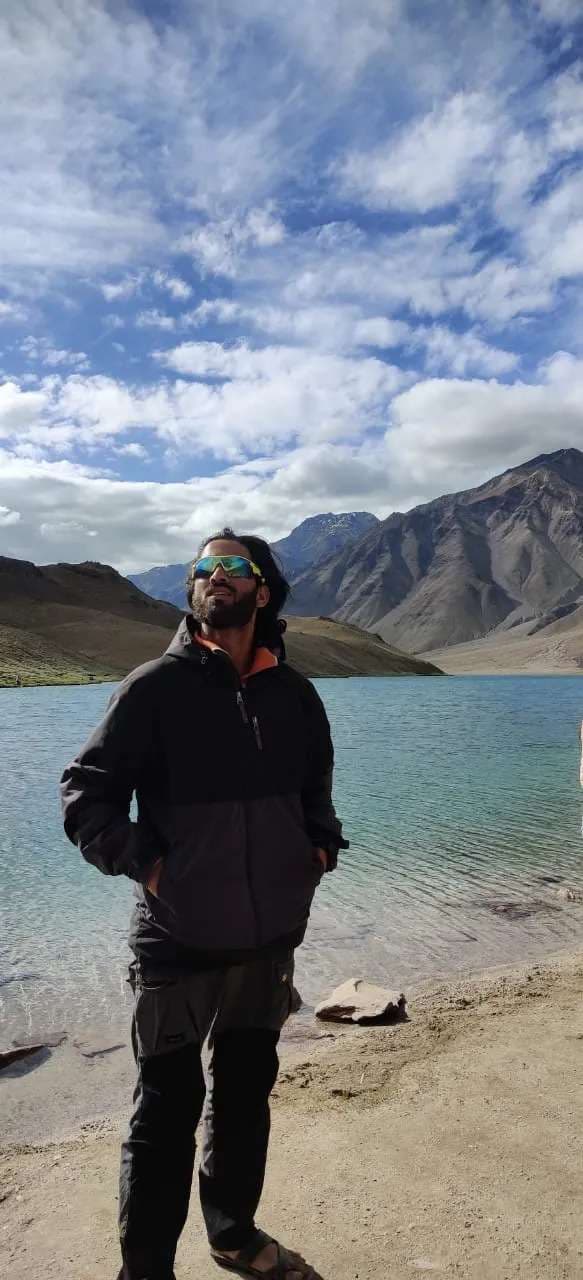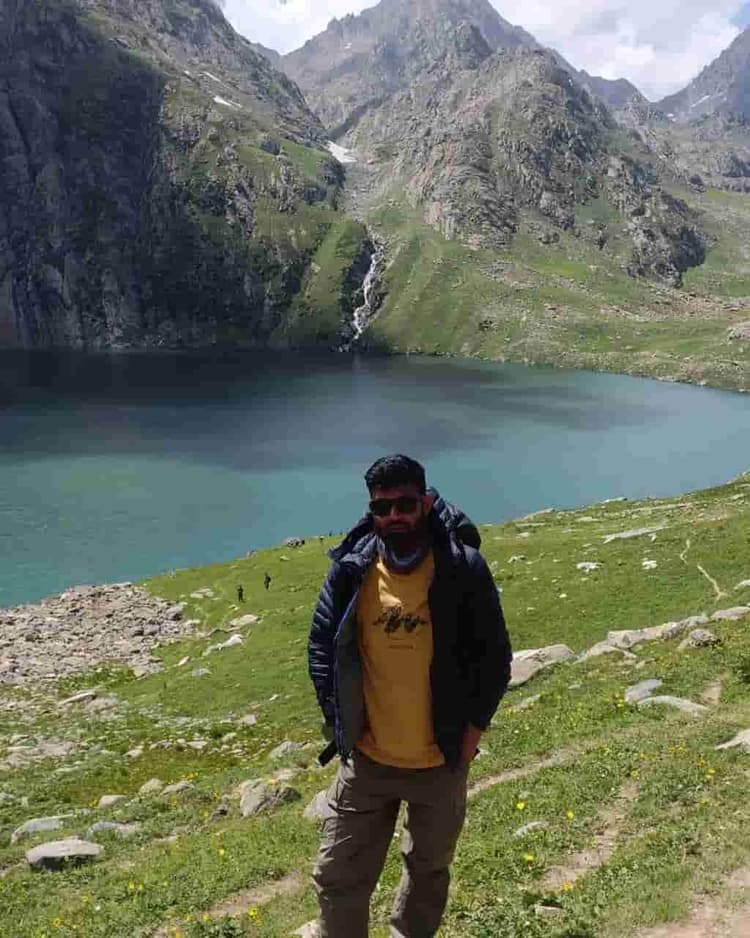Sar Pass Trek is a great choice for nature lovers as well as adventure seekers. Green forests, meadows, small villages, and snowy paths add to the charm of this exciting journey.
The trek starts from Kasol, a popular place for backpackers from all over the world, many of whom are city youths who came to enjoy its relaxed vibe. The shops are well-stocked with both necessities and luxuries.
One special thing about this trek is how the scenery keeps changing through evergreen jungles, grassy meadows, and snowy paths to colder regions. You would be able to see very rare flowers like Brahma Kamal and Rhododendrons. You might also see Himalayan wildlife like Tahr and Langurs, which would make the trip even more thrilling.
Trek Overview
Sar Pass is a high-altitude mountain pass in Parvati Valley, Himachal Pradesh, at an altitude of 13800 feet (4200 m). An unusual array of views will delight you as you transverse the trail—dense forests, alpine meadows, rocky landscapes, and snowy passes. Normally, the journey begins at the famous hill station Kasol. Kasol, 'Little Israel' as it's called, is popular for its nature with its calm atmosphere and picturesque scenery where the Parvati River flows in the middle of it.
The Sar Pass trek is not only about taking the pass; it deals with exploration of the journey through various terrains, including Greenland, dense pine forests and snowy regions. Viewpoints are clearly visible to trekkers as they go higher as there are stunning views of the surrounding ranges looking down into Trees, Tosh Valley and the Parvati Valley. There are also lovely camps along the way, which include Grahan, Min Thatch, Nagaru and Biskeri Thatch. All showcasing the magnificence of the region, which adds to the adventures and thrills of the journey.
Why Choose Sar Pass Trek?
Scenic Beauty: Passing through oak, pine, and deodar forests, the trek reveals picturesque views of the Himalayan ranges surrounding it. You'll find mesmerising meadows and gushing streams in exciting little towns, making it a delight for nature lovers.
Challenging Terrain: Moderate difficulty, the Sar Pass trek is the ideal trek for adventurous trekkers. The hills are steep; the peaks are narrow, and descents are tricky-it will thus pump adventure into every part of your journey.
Experience of Camping: You'll camp among the perfect Himalayan wilderness while trekking. Camps that can be pitched at Grahan, Min Thatch, Nagaru, and Biskeri Thatch are attractive locations to view and melt into nature.
Cultural Interaction: The beauty of the Sar Pass trek lies in the homely Himachali Villages, where you can enjoy their lifestyle with the locals. Get a taste of their culture, traditions, and food.
Adventure Activities: Sar Pass Trek also entertains itself with thrilling adventures like rappelling and rock climbing. All these make the trek very exciting.
Hot Springs: After completing a trek to Sar Pass, you can go to Manikaran in Kasol for hot springs nearby. The hot natural waters are considered sacred and have a medicinal effect. It works great for recovery from the trek.
Best Time to Visit
Most of the trekking is normally done between April and June, which is the best time to go for Sar Pass Trek in summer. An overview of the seasons and their features is given below:
Summer Season (April to June): Sar Pass Trek best time, as the weather is fair during the day, with moderate temperatures and cold nights. The itinerary is generally full of snow, thereby making trekking slightly difficult. The meadows are full of flowers and provide a colourful view and scenery in the beginning of the trail.
Monsoon Season (July to August): Monsoon rains are harmful, with trails filled with heavy rains. The Sar Pass Trek is thus avoided during this time due to the high risk of landslides and flash floods.
Post-Monsoon Season (September to October): Just after the monsoon clears, the weather will get clear, with landscapes full of lush green. This time frame is called the shoulder season for the Sar Pass Trek. Tourists are fewer during this time as opposed to the summer months, with trekking weather persisting well. But with every passing day, by the end of October, the temperature dips especially at night, so one must prepare for cooler conditions.
How to Reaching Manali & Kasol
By Air:
Bhuntar, adjacent to Kasol, has the closest airport at a distance of 31 km.
The flights linking Delhi and Chandigarh are frequent.
By Road:
Kasol, being on the road, has no trouble reaching by bus or taxi from different cities. Here are some of the common routes.
From Delhi: Board a direct Volvo AC bus from Delhi to Kasol. In case you would not find a direct bus from Delhi to Kasol, you can opt for Bhunter drop which is the biggest town near Kasol. From Bhuntar, hire a taxi or take a local bus to Kasol, which is about 30 kilometres away.
From Chandigarh: Travel to Kasol by bus or taxi can be done within 8 hours from Chandigarh.
From Manali: For those coming from Manali, you can take a local bus or hire a taxi to Kasol. Kasol is about 80 km from Manali.
By Train:
The nearest railway station is Chandigarh which is 310 km distant from Kasol.
Hire a taxi or bus from Chandigarh to Kasol.
How to Prepare for the Sar Pass Trek
The proper preparations ensure a safe and more enjoyable Sar Pass Trekking experience. Physical fitness and requisite trekking gear necessary to confront the challenges of this trek are the two bases of preparations.
Physical Training
Cardio: Activities like running, cycling or swimming help enhance endurance, which is necessary when trekking at high altitudes.
Strength: Strengthen your legs, core, and upper body with squats, lunges, planks, and push-ups to meet physical demands during the trek.
Stamina: Gradually ramping up the intensity of training forces you to build stamina for prolonged hours of trekking, as well as endurance for combined altitudes and climbs.
Trail walks: Short trail walks before heading out on a trek allow one to acquaint oneself with walking steadily on uneven terrain with a backpack.
Basic Gear for Trekking
Trekking Shoes: Get high-quality trekking shoes that have adequate ankle support and strong soles. Put them on before setting out on the trek to avoid getting blisters and discomfort along the trail.
Backpack: A lightweight backpack with padded shoulder straps and waist straps for snug-fit comfort and weight distribution.
Suitable Clothes: A Sar Pass Trek could invoke all sorts of weather for preparing, wicking breathable base layers, pants, warm woollen jackets, and, of course, an outer waterproof layer for all those weather slides.
Trekking Poles: They help stabilize and reduce pressure on knees when descending, particularly when descending over rocky land.
Other Essentials: Pack these in your travel bag for security: a headlamp, a few water bottles, a first-aid kit, sunscreen, sunglasses, a hat, and a trekking towel.
How to get fit for the trek
Physical preparation for the Sar Pass trek is a must to ensure that the trek experience is going to be pleasant and true. The steep climbs, the day-long trail walking, and trekking in the snow demand a lot of effort and endurance in often adverse weather conditions. Hence, here are ways one would get fit for the trek:
Cardio Training
Spend 30-45 minutes daily, either running, swimming, or cycling for stamina building.
Incorporate interval training (i.e., alternately high and low intensity) to condition for the steep ascent and long hours of walking.
Strength Training
Squats, lunges, and step-ups are good for leg muscle strengthening to manage uphill climbs.
Incorporate planks and core exercises to enhance balance and stability while traversing uneven terrains.
Flexibility and Mobility
Yoga and stretching will help you reduce muscle stiffness and lower the chances of injury.
Keep dynamic stretching in your pre-workout routine for flexibility.
Acclimatization and Endurance
Make sure you reach Kasol at least one day before the trek so you can adjust for the Sar Pass trek altitude.
Hydration & Diet
The Sar Pass trek weather can be unpredictable, so Drink at least 3-4 litres of water every day to stay hydrated.
Ensure a protein-packed balanced diet with fruits, nuts, and energy bars to keep up your energy levels for the trek.
Medical Checkup
Be sure to consult your doctor about trekking in the Himalayas and undergo any necessary medical checkups before joining the Sar Pass Trek.
Understanding the Sar Pass Trek Route Map
Knowledge of Sar Pass trek route map is extremely essential for preparing for the trekking environment. The trek begins from Kasol, one of the popular base camps of Himachal Pradesh, and crosses thrilling forest landscapes, meadows, and snowy trails. The first destination is Grahan Village at 6,350 feet. One gets to relish the serene ambience, then goes up to Min Thach around 13,780 feet, which gives a view to behold. The high point elevation is Nagaru, where you see the scenic mountains and valleys surrounding you. On the way down, you get to go through Biskeri Thach with lovely meadows. Next is the ultimate destination at Barshaini, 7,709 feet above sea level, where one is alive to the journey and sits, thinking before going to Kasol. With sufficient training and proper equipment, it would be a promising trek, with good scenery.
Safety Considerations for the Sar Pass Trek
Physical Fitness: Sar Pass Trek difficulty level varies between moderate to challenging. Treks like this require trekkers to have very good stamina and endurance. Long walks, steep climbs, and higher altitude walks will assign special significance to physical preparation.
Acclimatization: The Sar Pass Trek height is up to about 13800 ft; hence, acclimatization has to be done well. Spending at least one to two days at base camp will allow trekkers to acclimatize to higher altitudes and avert altitude sickness properly.
Weather Preparations: The weather in the mountain is famous for being changeable; hence, some weather forecasts must be made before starting the trek. Proper warm clothing, rain gear, and proper trekking equipment will make it safer and more comfortable.
Navigation: Due to the endless change in terrains while trekking, maps or GPS devices are the primary navigational tools for the trekker. Being together in a group is the safest option; moreover, the group must stick to the trail.
Hydration and Nutrition: the Sar Pass trek distance is roughly 48 kilometres long; therefore, a great deal of energy will be exerted. Hydration with water, along with energy donations like nuts, fruits, or energy bars, will help you get through.
First Aid: It is a valuable first aid box with bandages, antiseptic, painkillers, and other essential medicines that are well stocked. Basic first-aid training can save lives in the event of any major injuries.
Communication devices: fully charged mobile phone, waterproof cover, and essential emergency contact numbers. A whistle or the use of a whistle can well save your life in emergencies.
Professional Guidance: Hiring a trekking guide or a well-known trekking agency will take care of experienced assistance, local exploratory information regarding the location, and proper handling of potential issues.
Environmental Responsibility: Trekkers are advised to carry their waste materials according to the Sar Pass trek weather, be considerate towards wildlife, and be extremely cautious of local traditions.
Insurances: One must choose travel insurance, including insurance for trekking and emergency medical situations.
Using these protective measures, trekkers can safely go for the Sar Pass Trek and enjoy wonderful memories on this rewarding expedition. Complete the Sar pass trek booking according to the proposed dates to have a hassle-free experience since it would be well-planned.











